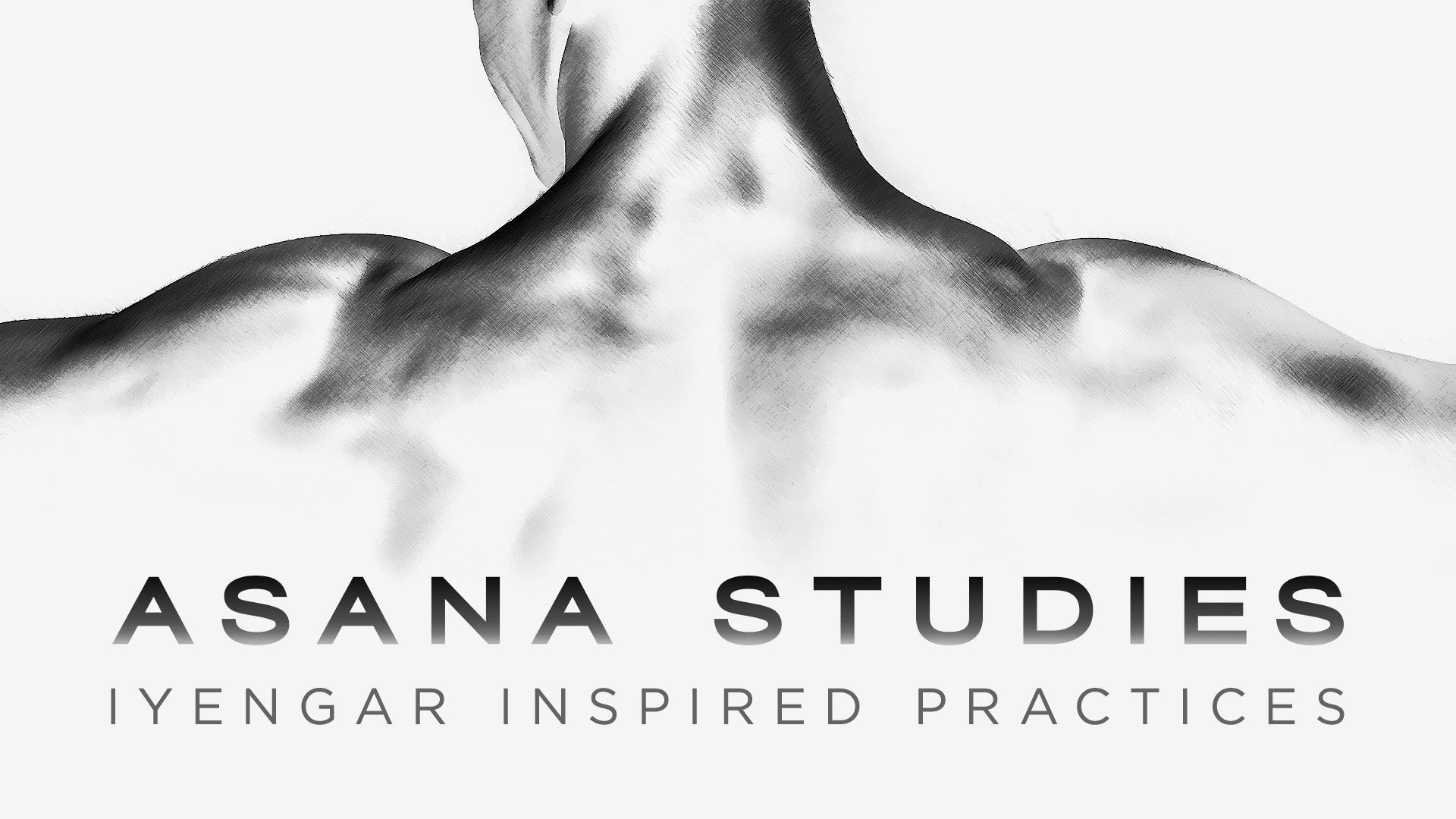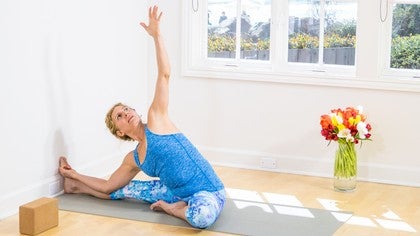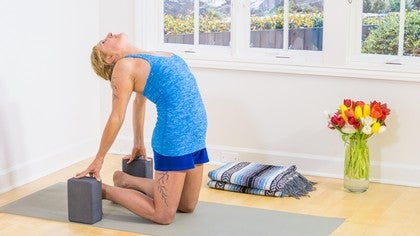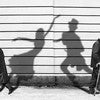Description
About This Video
Transcript
Read Full Transcript
(waves gently breaking) Hello and welcome. We are preparing for a restorative practice, so we will need some props. I have two blocks and two blankets and a strap. I also have a chair, and if you don't have a yoga chair, you can using a dining chair or your can use your couch. So a restorative practice is an incredible tool.
And I call it a tool because it's something that is an important aspect of yoga that we tend to know how to work hard, but we often forget how to not work or undo the work or be still, be quiet. So we're going to work slowly into the practice and see how quiet we can get. So the other skill part of it is not falling asleep. We really want to stay awake. We just want to kind work our body, work our mind, our nervous system, our breath, into a quiet place.
So let's come into a cross-legged position, and very simply we're gonna drop the chin to the chest, and we're really just thinking about the back of the body. Since we're addressing a quieter breath, we're trying to shift how the nervous system is moving us and how we are affecting the nervous system. So as I round forward in opening the space around the back of the spine, it's very simple. It's almost a quality of a fetal shape. The belly is soft, the throat is soft, the back is soft, and letting the head just hang.
So if you can, keeping just a tiny bit of weight in your hands, you can even shift side to side just to soften that back line from the base of the skull to the back of the pelvis. And then as quietly as you rolled down, we're gonna roll back up. Good, and then stretching your legs out. The same movements by letting the eyes drop, letting the throat soften, letting the back of the neck get open wide so as I roll forward, really allowing the spine to almost fan open, like the spinous processes almost fan away from each other. The back gets nice and wide.
The belly gets soft. The face gets soft. And letting the breath just find and soften the whole back line, soles of the feet, backs of the legs, back of the pelvis, lower back, middle back, upper back, back of the neck, base of the skull. And then as quietly as you came in, slowly roll up. Bending the knees, taking the knees wide, so making this comfortable if you can be just slightly away from the body.
Again, just nice and easy. So there's not an effort, there's not a sense of needing to do it right, there's really just a sense of how this tissue in the back of the body that holds me up all day, can I just slowly soften it with the breath. And so even though I'm folded forward and the breath isn't very deep, but there's a lightness, there's a softness. And again slowly rounding up, letting the roll up be as yummy as the roll down. Okay, so we're gonna need two blocks for Adho Mukha Balasana, the Child's Pose.
And if you need blankets behind your knees, so if you have any resistance in your knees you may want to put a blanket between your buttocks and your heels, or tightness in the fronts of the ankles, you might want to put a blanket under here, so whatever props you need. And then I'm going to rest my breastbone on the first block and my forehead on the second block. Down, if you need to adjust the props, if you have more breast tissue that you need to turn the block. So making yourself comfortable, head is supported, chest is supported, arms alongside the body. So again there's this sense of the back wide, that fetal position, almost kind of curling back into a nut state or a state of potential energy, dormant energy, turning in, folding in.
Inviting a light breath. A soft breath. And please stay in there for a few more breaths. Good, and feeling the earth beneath you. Good, since this is a pose often used in prayer, just feeling that sense of surrender or submitting.
That might not be an easy word, but a sense of letting, shedding what we don't need. Good, and then as quietly as you can, bring your hands under your shoulders and let your arms press you back up to sit. Good, just take a moment. Notice what's happening in your body. Notice what's happening in your breath and what's happening in your mind.
So just shifting, bringing hands towards the knees, we're just gonna shift up onto the feet, standing forward bend. So let's take these two blocks. Good, and we want to find the place where the legs are supporting us but there's not a lot of effort. So I'm actually gonna take one block between the feet, and you can even take the block wider, if that feels easier, and you're just holding the block more just to create a quiet stability in the legs. So I'm really just gonna focus the legs for this so that my hands aren't supported.
If this is any way aggravating, bend the knees or you can come back into Child's Pose. So either holding the ankles, holding the elbows, just fall open. Right, so the whole upper body just hangs down off of the legs. The head, the neck, you can even move the head around. Nodding, yeses and nos.
Let your eyes close, so that you're drawing back into your own body, your inner landscape, your own inner world. Okay, and let your breath get quiet. See if you can fall into your breath. See if you can let your breath find you, carry you. And letting the head go, noticing what's happening in the back of the neck.
Notice what's happening in the face and the lips and the shoulders. Good, and then let's quietly bend the knees, just shifting the weight into the legs. So bending the knees, shifting the weight into the legs, and we're gonna slowly round up. You've been down for a while, so take your time. The front body pushes up the back body.
Okay, and block off to the side. So take the feet wide. A very similar shape in that we're having the head down. So legs wide, toes slightly turned in, heels slightly turned out, and just shifting a little weight onto the outer edges of the feet, but letting the legs stay connected to your spine. Right, so they're drawn slightly in, slightly.
Put hands on hips, and we're just gonna sweep the sitz bones back, tipping the pelvis over the legs. Good, and letting the hands stay on the hips so that you can negotiate with the legs. Good. When you've come down as far as you can, bring your hands to the floor. Bring your hands under your shoulders.
Let your elbows bend or soften. Good, and the same quality of the legs are quietly stable to allow the spine to hang. Right, that the ribs are hanging, the spine is hanging, the lungs, the heart are hanging, the neck, the head. Let your eyes close, and simple nodding, chin up and down, chin side to side, nose side to side. Good, can you watch yourself get quiet?
Can you watch how the feet stand, and can they stand more simply and more softly? Can the legs stand more softly? Can the hands soften, the elbows soften, the shoulders soften? So in this space, in this allowing the body to get quiet, also noticing what's happening in the mind. So it may be there's less notice of the content of the chatter maybe even the cadence of your chatter is slower.
The volume is lower. Good, notice the back of the neck, the shoulders, the face, the mouth. Okay, and then let's just quietly lift up just enough so you can start to walk the feet in, just a little closer together, so that when you bend your knees, you feel like you're really standing on your legs. Good, arms are passive, head is passive, and the legs just slowly support you. The front of the body pushes up the back of the body or pulls up the back of the body.
Find your breath. So we're gonna move onto the floor. If you have a chair, a dining chair, ottoman, or a couch is fine. We are gonna come down onto our backs, and put our legs up on the chair. So now that I have my chair set up, I'm gonna slide it close my buttocks and I want to have my blankets handy, so that when I lay down and put my legs on the chair, I can then slide the blanket underneath my buttocks.
So again if you don't have a portable chair, you can use a dining chair or even your couch. So I'm going to put my legs up on the chair and lay down and then lift my hips up and put my blankets underneath. Okay, so it should feel quite comfortable. You want your legs to be able to relax. You want your heels to be in the right place so they don't feel like they're hanging off or poking into the chair.
Right, you don't wanna be distracted by the sensations. And then once you're here, closing your eyes. And so now that the pelvis is elevated, the chest is a little more open, and the breath can easily flow into the body. So just walking your awareness around your body, feeling your right leg settle into the chair, your left leg settle, your right arm, your left arm. Good, feeling the back of the body, the back of the head, back of the neck, upper back, middle back, lower back.
Feeling the face soften, the lips soften, throat, chest, belly, pubic area, pelvis floor soften, and as you soften, notice the breath. If you can, you can invite a slightly longer inhale and slightly longer exhale, but in that place of effortlessness, that there is no effort to taking more breath, that you're almost softening into the breath that was already there, that already existed. And when your mind wanders, gently find the breath. Let the breath find you. And then keeping that quality of softenness, coveting it, cherishing it.
Let's slowly bring your feet onto the edge of the chair and roll to your side, and come up to sit. So I'm gonna use these two blankets again. I'm just gonna open them out and fold them so they're long and narrow. So I'm gonna put my chair off to the side, and have my strap handy. And I'm gonna lay my back down on the blankets.
So I'm really setting my upper back or my rib cage on the blankets. And if you need a little support for your head, you can take the top of the blanket and flip it over. And walking feet together, knees together, and then letting the knees slowly open out to the side. Good, turning the palms up to the ceiling, and again letting the body find the breath. Letting the breath find the body.
The eyes closed. So as you did before on the chair, just letting the right leg settle, the left leg, the right arm settle, the left arm settle. And again noticing the quality of your breath and your thoughts, so as if you could look for the spaces between the thoughts. Right, as if you were looking for the breath, the space, the quiet between the sounds. So again, just holding or staying with riding that quietness, that simpleness, and just slowly draw the knees together.
If you need to use your hands to help you, please do so. So I'm just gonna take my strap, make a loop with my strap. And putting the strap around the thighs, so that my thighs end up about hip distance apart. Good, and keeping my upper back on this blanket. I'm just gonna straighten my legs.
Good, if you have some weight handy, you can put your block on your thighs. And see if you can move even deeper in watching the body get quieter still that there's a stillness inside, inside the legs, inside the arms, inside the torso, that we can learn to quiet from the outside in and the inside out, that we can learn how to move beyond that, the churning, the questions, the movement, into that stillness. So in this place where we're moving aside all the chatter and the mind gets clearer, or swimming through the chatter into the clear sky, clear ocean, silent mind, explore that quietness. Make peace with that quietness, and it becomes a refuge. So if your body, your mind, need more time here, please stay here.
And when you think you need to get up, stay longer. Thank you.
Asana Studies: Padma Borrego
Comments
Disc prolapse can be handled in different ways.
One is taking into account who the person is. Are they getting better, or is it staying the same. The body has an incredible capacity to heal especially if the input into the body has changed, eg, load distribution is more efficient, body is stronger and balanced. think of disc prolapse as a imbalance of strength or organization of the body. If she is getting better then experiment. you can start with the body more neutral. laying on the back with the spine neutral and doing variations with legs, arms, simple twists, then adding forward bends and back bends. gentle to start. less is more and then wait to see how the body handles it. she should feel more focus and strength in her body if you are going in the right direction. i hope i answered the question. if not please ask me to clarify. :)
You need to be a subscriber to post a comment.
Please Log In or Create an Account to start your free trial.















